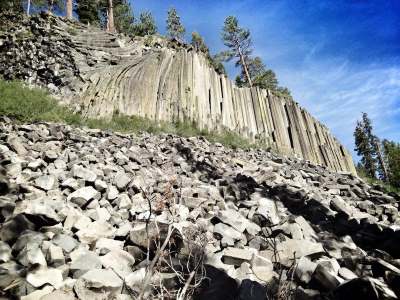
Many summer visitors to the Eastern Sierra choose the towns of June Lake and Mammoth Lakes as vacation destinations because of their proximity to Yosemite National Park’s thousands of miles of hiking trails. But did you know that you can hike similar terrain and see equally impressive natural wonders at Devils Postpile National Monument and the surrounding Red’s Meadow Valley? The Sierra Nevada’s granite monoliths, deep glacially carved valleys, and high alpine meadows attract people from all over the world seeking pristine wilderness and a sense of adventure, but locals know that we don’t have to stray far from Highway 395 to find these treasures in our own backyard.
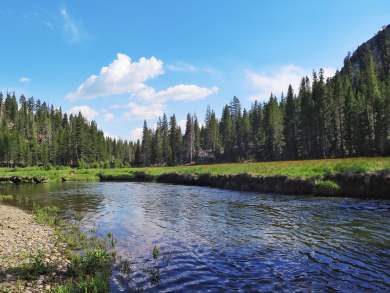
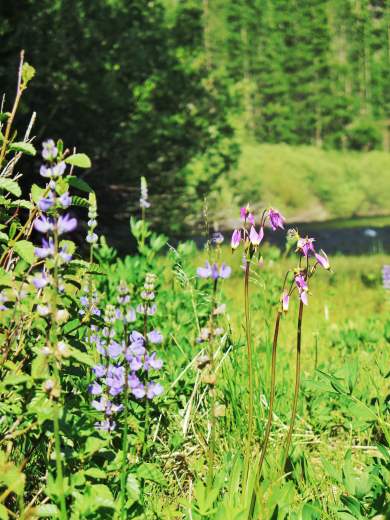
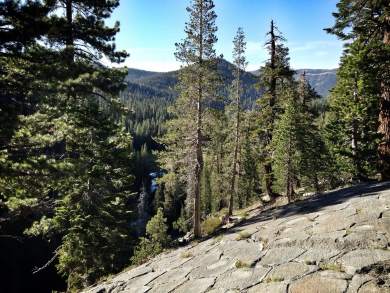
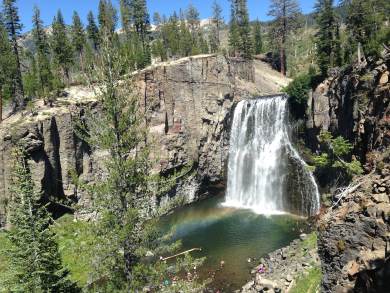
After enjoying the scenery and serenity of Rainbow Falls, hikers have the option to continue one more mile down the trail to see Lower Falls. There are fishing and swimming opportunities at this smaller but unique feature. Lower Falls is also typically less visited than the larger, more popular Rainbow Falls, so visitors seeking solitude with the wilderness are more likely to find a more peaceful space here.
Sometimes visitors don’t have enough time to make it all the way to Rainbow Falls but still want to see a classic Sierra Nevada waterfall. Minaret Falls is a great option in this case. It is smaller, more secluded, and worth the relatively short hike. Just 1.5 miles one way, the trail to Minaret Falls is moderate and hikers only experience about 125 feet of elevation change. You can access this waterfall by taking the Devils Postpile trail until the junction at the Soda Springs Bridge. After crossing the bridge, continue following signs for Minaret Falls.
The cascade at Minaret Falls is extremely variable depending upon the season. Spring is the best time to watch the snowmelt from the high country gush over the granite that forms the cascade feature. Springtime brings many wildflower species to this area as well. Later into the summer, Minaret Falls can look more like a trickle in anticipation of wintertime snow. Hikers can have a harder time identifying when they have reached Minaret Falls once the cascade dries up. Springtime is definitely the best season to see this feature in all of its glory!
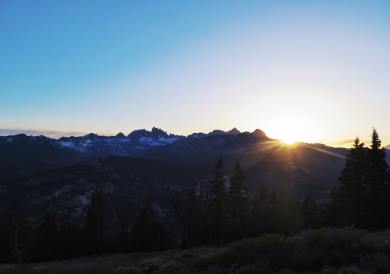
If you are looking for a more rustic way to get around to the popular destinations in the Red’s Meadow Valley, the historic Red’s Meadow Resort & Pack Station offers day trips on horseback as well as multi-day pack trips. For a reasonable rate, you can take in classic views of incredible destinations in the Sierra Nevada just as cowboys used to in the old days when the Eastern Sierra was mostly comprised of mining settlements. The day trip destinations range from 2-hour rides to Rainbow Falls up to half and full day rides along the Pacific Crest Trail to Minaret Falls, Red Cones, and Shadow Lake.
While in the area for your hike or pack trip, be sure to visit the General Store for snacks, beverages, and souvenirs. For a heartier option, try the Mule House Cafe at Red’s Meadow Resort for a delicious meal in a charming setting.
Be prepared for various trail conditions and unpredictable weather when hiking in the Sierra Nevada, regardless of the season. For the most part, all of the trails in the Red’s Meadow Valley are composed of well packed pumice, though there are sandier areas on sections of trail that are shared with pack animals. The elevation in the valley ranges from 7,500 to 8,500 feet, so hikers who are unaccustomed to exerting themselves at higher elevations should exercise caution to decrease the possibility of discomfort or illness. There are no water or restroom facilities on the trails in the valley and little to no cellular service. Weather can be unpredictable and extremely variable in the mountains. Hikers should plan ahead and bring adequate supplies for their adventures.
Summer is the best time to visit the Red’s Meadow Valley, as it is typically most accessible between the months May through October, weather permitting. During peak summer months (June through August) you can access the valley for day trips by riding the Red’s Meadow Shuttle, which makes regular departures from the Adventure Center at Mammoth Mountain Ski Area’s Main Lodge. When the shuttle is not running, you can drive into the valley and pay a fee at the US Forest Service fee station at Minaret Vista.
During the Spring and Fall, when Red’s Meadow Road is often closed to vehicular traffic, access to Devils Postpile, Rainbow Falls, and Minaret Falls can be trickier. Red’s Meadow Pack Station operates only when Red’s Meadow Road is open to traffic, so there are no facilities or shops available throughout the Red’s Meadow Valley when the road is closed for the season. Depending on weather, road, and trail conditions, there are two ways to access the Red’s Meadow Valley in the off-season. If trails and roads are clear, you can either hike into the valley on Red’s Meadow Road or follow the Mammoth Pass Trail from Horseshoe Lake in the Lakes Basin. Mammoth Pass Trail runs approximately 4 miles from Horseshoe Lake to a trail junction in Red’s Meadow, from which you can hike to Rainbow Falls, Devils Postpile, or Minaret Falls. Road and trail conditions are extremely variable depending on the time of the season and the weather. US Forest Service rangers at the Mammoth Lakes Welcome Center typically have the most updated information regarding trail conditions. Stop by for up-to-date information about hiking the Mammoth Pass Trail or Red’s Meadow Road if you are unsure!
If you are interested in owning a vacation home in a smaller town with less hustle and bustle than Mammoth Lakes, check out properties available in June Lake through Sierra Crest Real Estate. Situated just 20 miles north of Mammoth Lakes, the town of June Lake is a charming location that boasts plenty of year round recreation opportunities. Living in or owning a vacation property in June Lake offers you the convenience of being a short trip away from Devils Postpile and the Reds Meadow Valley, as well as Yosemite National Park. Call the Sierra Crest Real Estate office to find out more about properties available in June Lake and the surrounding communities and how you can supplement your income by allowing June Lake Accommodations to manage your property as a vacation rental!
This article was written by Leslie Redman, the newest member of the Sierra Crest Real Estate team. She moved to the Eastern Sierra three years ago and has created, written, and edited online content for the National Park Service, the Student Conservation Association, and her own personal travel blogs in the past. For more information about hiking and day trips in the Eastern Sierra, call her today at the Sierra Crest Real Estate office at (760) 648-7304.
© 2018 Junelakeaccommodations.com
We’ll send you updates on vacation rentals as well as what’s happening in the June Lake area.
Get exclusive info for our rentals in June Lake.
© 2025 | June Lake Accommodations All rights reserved.
Terms of Use | Privacy Policy | Sitemap | Owner Login | Guest Portal